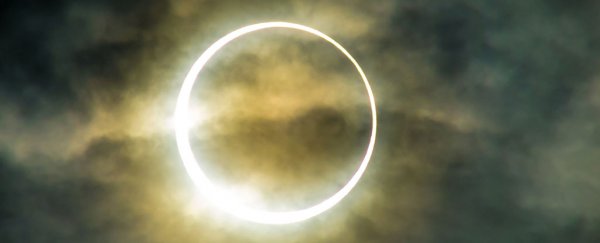Some 301 years ago, pioneering English astronomer Edmund Halley observed a solar eclipse, noticing an eerie change in the weather that coincided with the spectacle above.
Halley noted that the "chill and damp which attended the darkness… [caused] some sense of horror" among his fellow spectators, but could not figure out what was behind this so-called eclipse wind. Now, thanks to the help of thousands of volunteers, scientists might have finally solved the mystery.
Meteorologists from the University of Reading in the UK recruited around 4,500 citizen scientists for their National Eclipse Weather Experiment, designed to measure the meteorological effects of the partial eclipse that took place on March 20 last year.
Combining observations from across the UK with readings taken by surface weather stations and a network of roadside weather sensors, the team confirmed that the atmosphere did indeed cool during the eclipse, and slackening winds had also been registered.
According to the researchers, this change in wind conditions can be attributed to variations in Earths's boundary layer – the layer of air that separates high-level winds from those at ground level.
"There have been lots of theories about the eclipse wind over the years, but we think this is the most compelling explanation yet," says atmospheric physicist Giles Harrison.
"As the Sun disappears behind the Moon, the ground suddenly cools, just like at sunset. This means warm air stops rising from the ground, causing a drop in wind speed and a shift in its direction, as the slowing of the air by Earth's surface changes."
While the overall effects are more marginal than the long-debated 'eclipse cyclones' scientists observed more than a century ago, the changes are still noticeable.
Eclipse-induced cooling saw temperatures across the UK drop by around 1 degree Celsius (1.8 degrees Fahrenheit), although in some parts of the nation, the difference was as much as 4 degrees Celsius (7.2 degrees Fahrenheit).
Changes in wind speed were also detected, with speeds dropping by up to 4 knots (7.4 km/hr, 4.6 mph) in some parts of the UK. Not exactly the stuff of "horror" then, but a remarkable phenomenon regardless.
The findings are backed up by another study of the event by researchers at the University of Sheffield, which found a mean UK temperature drop of 0.83±0.63 degrees Celsius (1.5±1.1 degrees Fahrenheit), with the average wind speed dropping by 9 percent on average during the first half of the eclipse.
"Until recently, solar eclipses were eagerly studied by astronomers from the standpoint of examining the Sun's corona," said Astronomer Royal Sir Arnold Wolfendale FRS in a press release.
"The boot is now on the other foot, with satellite studies making solar studies 'easy' and interest shifting to meteorological aspects. The heightened importance of climate change leads to great interest in a variety of climate parameters which can be studied when, uniquely, 'the power is switched off'."
The researchers' findings will now need to be verified independently by further eclipse studies, and the best opportunity looks to be next year's total solar eclipse, which will give viewers in the US an amazing view of the Moon blocking the Sun. But you might want to organise your accommodation pronto, because interest is so high that hotels in the best viewing locations are getting booked fast.
Aside from helping to explain the eclipse wind phenomenon, the National Eclipse Weather Experiment also shows just how useful the public can be when they get engaged in the scientific process.
"The [Experiment] was, as far as we know, a world first, in measuring and analysing eclipse changes in the weather on a national scale, in close to real time, through engagement of a network of citizen scientists," the authors write.
It also makes for a fitting conclusion to a riddle that's puzzled researchers for more than three centuries.
"We thank the thousands of fellow scientists around the country whose measurements contributed to this research," said Harrison. "Halley also relied on combining eclipse observations from amateur investigators across Britain. We have continued his approach."
The findings are reported here and here in Philosophical Transactions of the Royal Society A.
